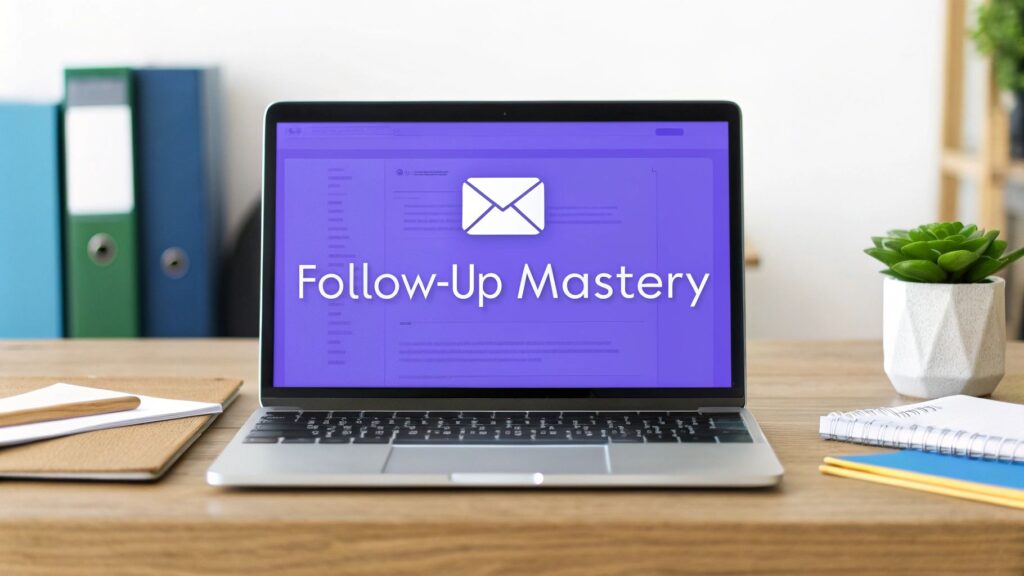What is Market Segmentation? Key Strategies Explained

Think about the last time you saw an ad that felt like it was made just for you. That’s market segmentation in action. It’s the process of taking a massive, jumbled market and neatly dividing it into smaller, more manageable groups based on what people have in common.
Instead of a one-size-fits-all strategy, this approach lets you tailor your products, messaging, and sales pitches to meet the specific needs of each group. It's about working smarter, not harder, to make sure your efforts actually hit the mark.
Why Market Segmentation Is Essential for Growth
Ever tried to sell a steak to a vegetarian? It just doesn’t work. At its heart, that’s what marketing without segmentation is like. You're trying to appeal to everyone at once, which usually means you end up appealing to no one.
Segmentation is the simple, yet powerful, idea of not treating every customer the same. Rather than shouting your message into a crowded room, you’re pulling aside smaller groups for more meaningful conversations based on their shared interests, needs, or characteristics.
This strategy isn't just a "nice-to-have" anymore; it's a fundamental part of modern business because customers expect to be understood. The numbers don't lie: around 81% of consumers say they are more likely to buy from brands that offer personalized experiences. And the impact on the bottom line is staggering—companies using segmentation have seen email revenue jump by as much as 760% compared to one-off, generic campaigns.
From Broad Audiences to Targeted Connections
By breaking down your audience, you can stop broadcasting and start connecting. Crafting a message that speaks directly to a small, niche group will always be more effective than a generic message aimed at a mass market. It’s the critical first step in figuring out how to identify your ideal target customers.
The infographic below really drives home the importance of knowing who you're talking to—the very foundation of any good segmentation plan.

When you truly understand the different types of people in your market, you can group them in ways that make sense for your business. This focused approach ultimately leads to a much better return on your marketing spend and helps build a customer base that feels seen, heard, and valued.
Core Benefits of Market Segmentation
Let's quickly break down the primary advantages that market segmentation brings to the table. When done right, it impacts nearly every part of your go-to-market strategy.
| Benefit | Impact on Business |
|---|---|
| Increased ROI | Focuses marketing spend on prospects most likely to convert, reducing wasted resources. |
| Enhanced Customer Loyalty | Personalized communication makes customers feel valued, fostering stronger, long-term relationships. |
| Stronger Brand Messaging | Allows for targeted messages that resonate deeply with specific audience needs and pain points. |
| Improved Product Development | Provides clear insights into what different customer groups want, guiding future innovation. |
| Competitive Advantage | Helps identify and dominate niche markets that larger, more generalized competitors might overlook. |
As you can see, the benefits go far beyond just better marketing campaigns. Segmentation is a core business strategy that drives efficiency, loyalty, and sustainable growth.
The Five Main Types of Market Segmentation
Knowing you need to slice up your market is one thing. Knowing how to slice it is another entirely. This is where the core methods of market segmentation come in. Think of them as different lenses you can put on to view your audience, with each one revealing a unique angle on their needs, habits, and what makes them tick.
By layering these methods, you can go from a blurry, one-dimensional picture of your customer to a rich, high-definition profile. Let’s walk through the five main types that businesses use to create these detailed portraits.
1. Demographic Segmentation
This is the classic, the one everyone starts with. Demographic segmentation is all about the "who," grouping people based on objective, statistical data. It might sound basic, but these attributes are often directly tied to purchasing power and preferences.
You’re looking at variables like:
- Age: A skincare brand isn’t going to market acne solutions to someone in their 50s. They’ll target teens with one product and offer anti-aging creams to customers 40 and over. For example, brands like Dove have separate product lines (e.g., "Dove Men+Care") that use distinct messaging and packaging for different age and gender groups.
- Income: A financial advisor will pitch investment products to high-net-worth individuals, not budget-conscious families who are more likely looking for a good savings account.
- Gender: Nike doesn't just run one ad campaign; they create distinct product lines and marketing messages for men and women, with sponsorships of athletes like Serena Williams and Michael Jordan to appeal to each segment.
- Education Level: An ed-tech company selling advanced research software will talk to postgraduate students very differently than it talks to high schoolers.
Demographics give you a solid, reliable foundation for any segmentation strategy.
2. Psychographic Segmentation
If demographics tell you who is buying, psychographics tell you why they’re buying. This is where things get interesting. You’re grouping people based on their internal wiring—their personality, values, interests, and lifestyles. It’s all about getting inside their heads.
A brand like Rolex isn't just selling a watch that tells time. They're selling a symbol of success and prestige. They use psychographic segmentation to target ambitious, driven people who value status, not just anyone with a high income.
This is how you build a genuine emotional connection. A company like Patagonia targets people who value environmentalism and outdoor adventure, crafting messages that speak directly to their core beliefs. Their "Don't Buy This Jacket" campaign was a masterclass in appealing to anti-consumerist values, strengthening their bond with their core audience.
3. Behavioral Segmentation
This one is pure action. Behavioral segmentation divides your audience based on how they’ve actually interacted with your brand and products in the past. It answers the simple question, "What do they do?"
This is powerful stuff because past behavior is one of the best predictors of future action. The data points you’re looking for are:
- Purchase History: An online store like Zappos can send a runner special offers on new running shoes because they know they've bought athletic gear before.
- Brand Loyalty: Starbucks created its entire rewards program to give perks to its most frequent customers, making it a no-brainer for them to come back again and again. In fact, rewards members now account for over half of all U.S. company-operated sales.
- Usage Rate: A SaaS company can spot its power users and ask them for a testimonial, while offering extra training to light users to help them get more value from the product.
When you analyze these actions, you can create marketing that feels incredibly timely and relevant.
4. Geographic Segmentation
This is as straightforward as it sounds: grouping customers based on where they are in the world. A person’s physical location has a huge impact on their needs, culture, and buying habits. This can be as big as a continent or as small as a zip code.
The classic example is a retailer like The North Face promoting heavy parkas in Minnesota while advertising light jackets and shorts in Florida. It’s common sense. In the same way, a national restaurant chain like McDonald's might tweak its menu in different countries to feature local flavors and ingredients, such as the McSpicy Paneer in India or the Teriyaki McBurger in Japan.
5. Firmographic Segmentation
While the first four types are mostly for consumer-facing (B2C) businesses, firmographic segmentation is the B2B equivalent. Instead of segmenting people, you’re segmenting entire organizations based on their specific attributes.
This is an absolute must-have for B2B sales and marketing teams trying to pinpoint their most valuable accounts. Common firmographic variables include:
- Industry: A cybersecurity firm will have completely different solutions and sales pitches for a hospital (focused on HIPAA compliance) than it does for a bank (focused on financial data protection).
- Company Size: A software provider like Salesforce offers a basic plan for small startups and a completely different enterprise solution for massive corporations with thousands of employees.
- Annual Revenue: This data helps sales reps qualify leads and know how to frame pricing discussions before they even pick up the phone.
When you start combining these five types, you can create incredibly specific and effective segments. It’s how you make sure the right message gets to the right people, in the right place, with the perfect context.
Why Segmentation Is a Business Game Changer
Let's be honest, market segmentation isn't just a marketing buzzword. It's a fundamental business strategy that directly fuels growth. Forget the old "spray and pray" method—blasting the same generic message to everyone and hoping something sticks. That's just a great way to burn through your budget.
Segmentation is about precision. It lets you focus your time, energy, and money on the people who are actually looking for what you sell. This focused approach is what separates wasteful spending from profitable, measurable marketing.

Driving Smarter Product Development
Good segmentation gives you a clear window into what your customers truly need. By breaking down your market into distinct groups, you can see their unique challenges and desires. This means you can stop guessing and start building products that solve real problems.
Imagine a software company that sells a complex, enterprise-level platform. Through segmentation, they might discover a whole group of small business owners who love the concept but need a stripped-down, affordable version. Without that insight, this entire profitable niche could have stayed hidden. It ensures your roadmap is actually aligned with real market demand.
By understanding the distinct needs of different customer groups, businesses can reduce customer churn by as much as 15%. Segmentation doesn't just attract new customers; it gives you the insights needed to keep them.
This intense focus on the customer is how you turn a one-time buyer into a loyal fan.
Building Lasting Customer Loyalty
When you get segmentation right, personalization becomes second nature. And personalization is the bedrock of strong customer relationships. It's simple human nature—when people feel like you "get" them, they're far more likely to stick around. In fact, companies that master personalization generate 40% more revenue from those efforts than their competitors.
This creates a much deeper connection, boosting loyalty and keeping customers from walking away. A huge benefit of segmentation is how it sharpens your ability to keep the customers you've worked so hard to win. To dive deeper into this, check out these Top Customer Retention Strategies.
Ultimately, market segmentation gives you a strategic roadmap for steady, sustainable growth. It helps you:
- Allocate Resources Efficiently: Put your budget where it will actually make a difference.
- Strengthen Brand Messaging: Craft messages that truly connect with specific groups of people.
- Gain a Competitive Edge: Find and serve overlooked markets your competitors are ignoring.
By adopting segmentation, you move from just selling a product to providing real solutions for specific people, creating a powerful engine for long-term success.
How to Build Your Segmentation Strategy
https://www.youtube.com/embed/ZoOuNv8TXLs
Knowing what segmentation is and actually putting it into practice are two very different things. The key is to stop thinking about it as some massive, complex project and instead see it as a clear, step-by-step process. This isn't about aimlessly collecting data; it's about building a roadmap.
Think of this framework as a feedback loop. Your first try won't be perfect, and that’s okay. It’s the starting line for a much smarter, more focused way of reaching your customers.
Start by Setting Clear Goals
Before you even glance at a spreadsheet, you have to know what you’re aiming for. What does success look like? Are you trying to get existing customers to stick around longer? Break into a totally new market? Or maybe just improve conversion rates for a specific product?
Your goals are the lens through which you'll view everything else.
For example, a SaaS company might decide its main goal is to cut customer churn by 10%. Just like that, their focus sharpens. They're no longer looking at all customer data, but specifically at what separates the customers who leave from the ones who stay. They might analyze usage patterns to find that users who don't adopt a key feature within 30 days are 50% more likely to churn. That insight creates an actionable segment to target.
When you set measurable goals, you tie your segmentation efforts directly to business results. This keeps you from getting lost in the data weeds and ensures your strategy has a real-world purpose.
Gather and Analyze Relevant Data
Once you have your goals, it's time to collect the right information to meet them. You don't need every bit of data out there—just the pieces that help answer your specific questions.
Your best data sources are usually right under your nose:
- CRM Data: This is a goldmine. Your customer relationship management system holds purchase histories, communication logs, and account details that are packed with behavioral and firmographic clues.
- Website Analytics: Tools like Google Analytics show you exactly how people interact with your site. You can see which pages they love, where they get stuck, and what content actually grabs their attention.
- Customer Surveys: Sometimes, the easiest way to get an answer is to just ask. Direct surveys give you priceless psychographic insights into your audience’s true needs, challenges, and motivations. A simple one-question Net Promoter Score (NPS) survey can quickly segment your customers into Promoters, Passives, and Detractors.
This is also a great time to look at the bigger picture. The market is always shifting. For instance, 47% of consumers now say that buying from locally owned companies is important to them. This points to a growing desire to support domestic businesses—a powerful insight you could use to segment your audience.
Develop Segments and Personas
With your data in hand, you can start looking for patterns and grouping your audience into logical segments. The trick is to create segments that are not only distinct from one another but also easy to reach and big enough to be worthwhile.
Once you’ve defined your groups, it’s time to bring them to life with buyer personas. A persona is basically a character sketch of your ideal customer within a segment, complete with a name, goals, and frustrations.
You might create "Startup Steve," a founder who's obsessed with finding tools that can grow with his company, or "Corporate Carla," a manager at a large enterprise whose top priorities are security and seamless integration. Our guide on how to create buyer personas walks you through this process in detail.
Creating personas turns abstract data into relatable human stories. This makes it easier for your marketing and sales teams to empathize with customers and craft messages that genuinely connect.
Test, Measure, and Refine Your Approach
A segmentation strategy isn't a "set it and forget it" project. It's a living, breathing part of your marketing that needs constant attention and refinement. To get the most out of your work, it’s worth digging into different customer segmentation strategies to see what fits best.
Roll out campaigns tailored to each segment and watch the numbers closely. A practical way to do this is through A/B testing. Send one message to your "High-Value Customers" segment and a different one to your "At-Risk Customers" segment. Then track key metrics: Are conversion rates going up? Is engagement better? What’s the customer lifetime value looking like?
If a particular segment isn't responding the way you expected, don't be afraid to go back to the data and tweak your approach. Constant analysis and adjustment are what keep your strategy sharp and effective over the long haul.
Using Technology for Smarter Segmentation
Gone are the days when market segmentation meant spending months on manual research and guesswork. Today’s technology has completely changed the game, turning a once-static exercise into a dynamic, data-fueled strategy. The right tools can elevate a good segmentation plan into a great one, giving even small teams the power to target with incredible precision.

It all begins with your data hubs. Think of your Customer Relationship Management (CRM) system as the brain of your operation, capturing every customer interaction, purchase, and conversation. When you connect your CRM to analytics platforms, you start to uncover the behavioral patterns hidden in that data—not just who your customers are, but how they actually behave.
But your internal data only tells part of the story. To get a complete, 360-degree view, you need to layer in external information. This is where exploring the best data enrichment tools becomes a game-changer. They can add crucial firmographic and technographic details to your customer profiles, filling in the gaps and giving you a much clearer picture.
The Rise of AI and Predictive Segmentation
The real leap forward, however, is coming from artificial intelligence (AI) and machine learning. These technologies can sift through massive datasets to find subtle connections and patterns that a human analyst could easily miss. This is what shifts you from reactive segmentation to predictive segmentation.
Instead of just grouping customers based on what they've done in the past, AI can forecast what they're likely to do next. It can pinpoint which leads have the highest chance of converting, identify customers at risk of leaving, and even predict which segments will be most excited about a new product.
Predictive segmentation is all about getting ahead of your customer's needs. It's about anticipating what a group will want and reaching out with the perfect offer before they even realize they need it. This proactive approach is a powerful way to build loyalty and stay one step ahead of the competition.
Making Advanced Segmentation Accessible
This isn't just a fantasy for giant corporations anymore. The AI marketing industry is on track to hit $356.05 billion by 2030, a surge driven by its ability to create hyper-personalized experiences. This explosive growth is making sophisticated tools more affordable and user-friendly, allowing businesses of all sizes to automate the heavy lifting of data analysis.
By integrating modern technology into your process, you can:
- Automate Data Analysis: Let algorithms do the hard work of finding your most valuable segments quickly.
- Enable Dynamic Segmentation: Create segments that update automatically in real-time as customer behavior evolves.
- Personalize at Scale: Send perfectly tailored messages to thousands of individuals without lifting a finger.
Ultimately, technology gives you the power to move beyond basic, one-dimensional segmentation. It provides the tools to understand your customers on a much deeper level and engage them with the right message at exactly the right time.
Your Top Market Segmentation Questions, Answered
Alright, you get the theory. But when the rubber meets the road, real-world questions always pop up. This is where a great strategy can fall apart if you don't have practical answers.
Let's walk through the most common hurdles people face when they start segmenting their market. Think of this as your field guide to turning a smart idea into a plan that actually works.
How Many Segments Should We Actually Create?
This is a big one, and the honest answer is there's no magic number. But more isn't automatically better.
A great starting point is to aim for two to four well-defined segments. The goal here is balance. You want groups that are distinct enough to need a unique message but large enough to be worth your time and effort. For example, a B2B SaaS company might start with three simple segments: Small Businesses (1-50 employees), Mid-Market (51-500), and Enterprise (500+). This is manageable and directly ties to different product tiers and sales cycles.
If your segments are too big and generic, your messaging will feel watered down and won't connect with anyone. Go too small, and you'll burn out trying to manage a dozen tiny campaigns with minimal returns. The sweet spot is creating groups you can manage effectively and that represent real revenue opportunities.
What Are the Biggest Mistakes We Need to Avoid?
Segmentation is a game-changer, but a few common slip-ups can completely derail your efforts. Knowing what they are ahead of time is half the battle.
Here are the most common pitfalls we see:
- Going Too Niche: It's easy to get carried away and create a segment so specific that it's just not profitable to chase. A segment must be substantial enough to justify the marketing investment.
- Trusting Bad Data: Your entire strategy hinges on the data you use. If it's old, incomplete, or just plain wrong, you're building on a shaky foundation. Regularly cleaning your data is non-negotiable.
- Forgetting to Evolve: Markets shift, customers change, and new competitors show up. The segments that worked wonders last year might be totally irrelevant today.
- Doing Nothing With It: This is the cardinal sin of segmentation. You do all this incredible work to define your audience, only to send everyone the same generic email blast.
Remember, your segments must be actionable. If you can't measure a segment or tailor your approach to it, it's just a pointless data-organizing project.
How Often Should We Revisit Our Segments?
Market segmentation isn't a one-and-done project you can file away. It's a living strategy. Your customers are always changing, and your segmentation needs to keep up.
As a best practice, plan to do a full review of your segments at least once a year. This keeps them sharp and aligned with current market realities. A B2B company might find that a certain industry segment has doubled in value over the past year due to new regulations, requiring a complete strategy shift.
You'll also want to revisit them immediately after any major business event, like:
- A big disruption hits your industry.
- A new competitor changes the game.
- You launch a new product or pivot your services.
Treating segmentation as an ongoing process is what separates the companies that stay relevant from those that get left behind. It ensures your marketing is always on target.
Ready to stop guessing and start targeting startups with proven buying intent? FundedIQ delivers monthly lists of recently funded companies, complete with the verified decision-maker contacts and data insights you need to craft the perfect pitch. Find your next high-value client today.





